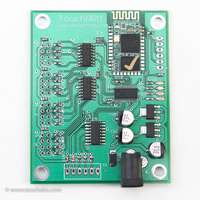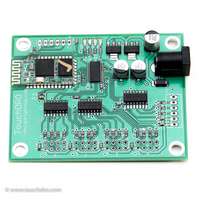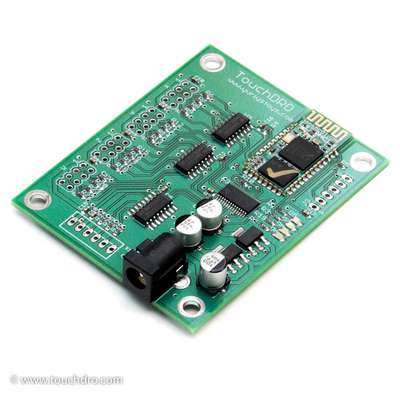
Wireless DRO Controller for Glass Scales - Deluxe Kit
This TouchDRO Controller (full version) for Glass and Magnetic DRO Scales. It supports up to four scale inputs, tachometer and tool height setter/touch probe input.
Inlcluded: fully assembled, programmed and tested controller board. To complete the setup
You Provide: 7-12 V DC power supply, enclosure, scale connectors
Description
TouchDRO Quadrature DRO controller works with Glass and Magnetic DRO scales that output either differential (RS-422) or single-sided (TTL) incremental quadrature signal. This includes most modern DRO scales on the market, including Ditron, Easson, Sino, some Acu-Rite models and many others.
The controller is engineered for industrial application and offers excelled noise immunity, reliability and repeatablity. To ensure long service life for the controller and the scales, the controller uses purpose-made RS-422 interface chips, name brand capacitors rated at at least double the expected input voltage, low dropout voltage regulator and high quality PCB.
All genuine TouchDRO controllers are fabricated and assembled in the USA to stringent IPS-A-600/610 Class II or better standard and use quality name brand components for best reliability and durability. I personally inspect every board and run it through a full range of tests (scale connectivity, bluetooth, etc.) before shipping it to you.
Specifications
Features
| Scale Intputs | 4 |
|---|---|
| Angular Axis | Yes* |
| Tachometer Intput | Yes |
| Probe/Height Setter | Yes |
| Power Supply | 7V DC - 12V DC |
| Current Draw | Approx. 50 mA |
| Width | 2.325" |
| Letgth | 2.9" |
* Shares input with the fourth linear axis
Supported Scales
Controller supports Glass or Magntic DRO scales that output TTL or RS-422 quadrature signal. This inludes:
- Ditron
- Eassong
- Sino
- Many others
Mechanical Drawings
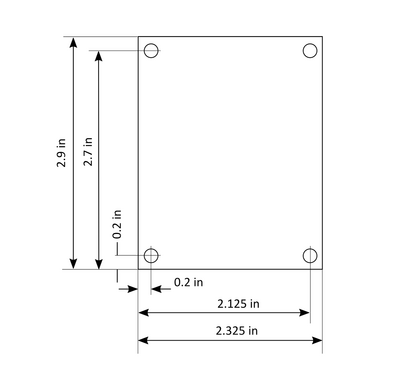
Documentation
Scale Connection
Majority of the scales on the market use a standard DB-9 female connector (AKA 9 pin D-Sub) but the pinout differs between different manufacturers. To determine the pinout of your particular scales please refer to the scale's user manual.
D-sub connector pin numbers go from left to right, top to bottom on a male connector with wider part at the top and pins facing the viewer, as shown in the picture below. Since in this case we are dealing with female connector, position it with the back facing you and wider side on top as shown in the picture.

After identifying the pin functions, push the pre-crimped connectors into the corresponding holes on the female connectors. The connections should be as follows:
Please note, most models of glass scales have separate connections for Ground and 0V. For the scale to operate correctly 0V needs to be connected to the Ground pin on the TouchDRO board. Please refer to the Grounding section for more details on proper ground connection
- Black - 0V
- Red - +5V (Vcc)
- Green - A primary
- White - B primary
- Blue - A secondary (marked A' or A with an overline)
- yellow - B secondary (marked B' or B with an overline)
Secondary (complimentary) A and B lines are available only on RS-422 scales. For TTL "single ended" scales blue and yellow wires are not required and should be either removed from the connector or tape-off to avoid shorts.

Port Functions
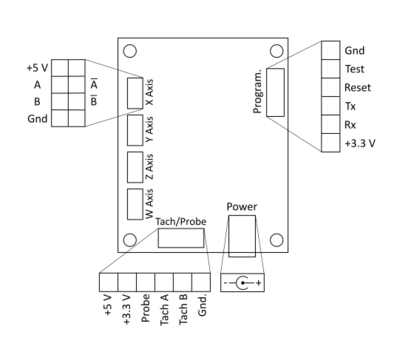
| Port | Description |
|---|---|
| X,Y,Z,W Inputs | Inputs for four linear axes. |
| Tach/Probe | Buffered tachometer and probe inputs. Directional tachomter requires optical encoder with quadrature input. For single pulse input use only "A" line |
| Power | Power supply input. Requires DC power source between 7V and 12V DC. Most optimal voltage is around 6V. Higher voltage will result in more heat around the voltage regulator; lower voltage might cause brownouts. |
Axis Input Pin Functions
Inputs for the scales are located along the left edge of the board, with first axis (X) on the top and last (W) at the bottom. Each connection uses a 2x4 pin header that has the following connections:
- Vcc - +5V supply for the scale
- A - primary input from A channel
- A' - complementary input from A channel
- B - primary input from B channel
- B' - complementary input from B channel
- Ground - 0V (connected to the chassis ground
Inputs A' and B' are optional. If left unconnected, they will be pulled down to the ground and the readout will still work as expected. If the scales support differential output, it's recommended to use all four channels for better noise immunity. Otherwise the exposed pins of the unused wires need to be isolated to prevent them from shorting something out.
Tachometer
The board is setup to accept a directional tachometer that has either push-pull or line driver quadrature output. For directional input connect Vcc to either 3.3V or 5V (depending on your particular sensor), A and B output, and Ground. If B is not connected the tachometer will be non-directional.
Note: there are some rotary encoders that provide open-collector (also called NPN) output that need additional parts to adapt to the board. Namely, the pins need to be pulled up to Vcc via 5K resistors.
Touch Probe
Inexpensive touch probes and tool height setters work similar to a simple electrical switch. Depending on the configuration, when the probe touches the workpiece it either opens the circuit, or closes it (normally-closed or normally-open, respectively). TouchDRO board supports (and automatically detects) both flavors.
The probe can be connected as follows: connect one side of the switch to Vcc (5v or 3.3V) and the other to the probe pin. If the probe has an LED, it has to be reverse-biased (backwards), or the input won't work. To test this, connect the probe to Vcc and Ground. If the LED lights up (either when the probe is touching, or not touching), reverse the leads.
Grounding
Proper grounding is very important for stable operation of the DRO unit. Although industrial-grade glass and magnetic scales aren't nearly as sensitive to EMF as their capacitive counterparts, electrical noise can still cause problems. The easiest way to reduce EMF issues is to ground the board to the machine's frame. Mounting holes on the board are tied to the ground fill, as are all of the ground pins.
Most glass and some magnetic scales have two separate connections for Ground and 0V. Ground is usually connected on the scale side to the cable shielding braid or foil, and is isolated from the outside shrowd. For best noise immunity make sure that the groudning braid is connecte to the ground only one one end, preferable next to the board.

